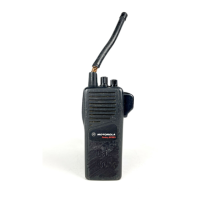4-4 6880904Z07-O August, 1996
Theory of Operation GP350 Portable Radios Service Manual
Frequency Generation Circuitry
When a “high” impedance is applied to U251 pin 5, the VCO
is operating in BATTERY SAVER mode. In this case, both
the receive and transmit oscillators as well as the receive,
transmit, and pre-scaler buffer are turned off. In the Frac-
tional-N, the battery saver mode places the A/D and the
modulation attenuator in the off state. This mode is used to
reduce current drain on the radio.
GP350 receive (RX) and transmit (TX) circuits are common
to both the VHF and UHF models. Most of the radio process-
ing for RX and TX is accomplished in U402, the Audio Filter
IC. The Audio Filter IC performs the following functions:
• Tone/Digital PL encoding and decoding
• PL rejection filter (RX audio)
• TX pre-emphasis amplifier
• Limiter
• Post-limiter filter
• TX deviation digital attenuators
• MIC gain attenuator
• Noise squelch digital attenuator
• Microcontroller port expanders (output only)
• 2.5 Vdc reference source
U402 parameters are programmed from U401 microcontrol-
ler ROM and EEPROM data via the serial CLOCK and
DATA lines. Unless otherwise indicated, all signal levels
refer to standard carrier modulation, 1kHz tone at +/-3kHz
deviation.
TX Audio Path
Internal MIC Bias Switch and External PTT Sense
Circuits
PNP switch transistor Q407, resistors R453, R454, and
capacitor C463 control the operating bias for internal MIC
MK401. Q407 is controlled by microcontroller U401 via
U402-40, the Audio Filter IC expanded output port. On con-
necting an external MIC through the side connector adapter,
the external PTT sense transistor (Q408) switches “on” when
the external PTT is closed. In PTT-equipped accessories, the
PTT switch is series-connected with the MIC element. When
this PTT is closed, 5-volts “high” is produced on the collec-
tor of Q408 and monitored by U401-14. When the collector
voltage is “high” (5 volts), the microcontroller configures the
radio for transmit mode.
There is no series-wired PTT within the headsets. These
accessories always keep the collector of Q408 “high.” With
headsets, the radio must be programmed for headsets or
Audio Sense. When programmed for Audio Sense, on
power-up the microcontroller (U401) reads that line 14 is
“high” and interprets that there is a headset attached. When
the radio is programmed for headsets, the microprocessor
ignores line 14 for PTT operation and it “looks” to the VOX
detect line on U401-19, or to the internal PTT (U409-42), to
transmit the headset audio.
MIC Amplifier
There are two MIC amplifiers inside U409. The MIC-enable
line, U409-18, is always biased “on” for VOX applications.
The amplifiers are selected according to the bias on U409-
20, which is the collector voltage on Q408. The external
audio amplifier, U409-21, is active when U409-20 is “high”
(5 volts), and the internal audio amplifier, U409-22, is active
when U409-20 is low (0 volts). The audio signal then exits
U409-19 and proceeds through a low pass network (C516,
C517, and R516) into U409-12 and out through U409-11,
with R515 providing feedback. This circuit supplies a low
frequency “roll off” for improved audio clarity. Capacitor
C519 and resistor R518 provide the output bias for the MIC
amplifiers.
TX Audio Mute Gate
PNP transistor Q409, and resistors R462 and R463 comprise
the TX audio mute gate. The audio Filter IC expanded output
port (U402-40), controls Q409 as well as the internal MIC
bias switch (Q407). When U402-40 is logic LO state, a small
dc current flows from U409-11 MIC amplifier output into
Q409 emitter, through Q409, and out of the collector through
R462. A fraction of the emitter current flows out of the base
through R463 to ground (Vss of Audio Filter IC). MIC audio
at U409-11 passes through the TX audio mute gate. When
U402-40 is logic “high,” Q409 base voltage is 4Vdc (typical)
and emitter voltage is 2.4 Vdc, biasing the device well into
cut-off. No current flows through emitter to base/collector,
and no MIC audio passes. The mute function is enabled
(Q409 is “OFF”) when modulating DTMF or 5/6 tone (Euro-
pean) Signalling.
Pre-emphasis Amplifier (standard models)
U402, the Audio Filter IC, contains a TX audio pre-emphasis
amplifier, with external gain setting resistor R504, and pre-
emphasis elements R506 and C462. Connections are made at
each end of resistor R506 to provide interconnection of
“front cover” option board TX audio through connector P1
(below). Pre-emphasis is 6 dB/octave.
Option Interface Connector P1 (Keypad/Display
models)
P1 provides interconnection of “front cover” option PC
boards to the GP350 radio main board. MIC audio output is
available from P1-5 at a level of 45 mVrms and 10k ohm out-
put impedance. Option TX Audio input to the GP350 radio is
available at P1-4 with sensitivity of 40 mV rms, pre-empha-
sized at 6 dB/octave, and less than 200 ohm output imped-
ance (from option board). If “flat” audio response is
required, the audio output from the option board must be de-
emphasized at a -6 dB/octave rate, 300Hz to 3kHz, with 0 dB
gain at 1kHz. The low option board output impedance is
required to achieve better than 40 dB isolation between main
board input (P1-4) and output (P1-5) audio.

